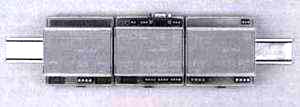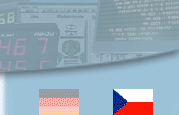|
|
|
|
|
|
|
|
|
|
|
|
Last update :
14. 4. 2016 000 11:31
|
|
|
|
|
HARDWARE |
|
|
|
|
| MODULES FOR THE SERIAL COMMUNICATION |
|
|
|
|
| PSK MAIN MODULE |
|
It communicates with the environment - e.g. with a PC or with another programmable automatic equipment - by means of a serial data line. The data line is galvanically separated and it can be set for RS 485, RS 422 or RS 232. The data line is terminated in terminals on the module. The second data line RS 232 is disposable for a configuration of the module and for service purposes. The second data line RS 232 is terminated in a connector CAN 9.
|
 |
|
The modules type SSK and VSK are connected to the module PSK by a 10-pole flat cable that is used for connection of both input and output modules.
The module includes 3 galvanically separated inputs that are disposable. We expect that it will be used for the test of the communication devices and for easy implementation of functions of fault signalling (fault confirmation, shut-down of the audible device).
The module also includes 4 outputs - type open commutator. 2 of the outputs are used for co-operation with controlled stabilizer, 1 of the outputs is used for operating of audible signal and the last output is used for external signalling of a communication fault.
A microprocessor type 89C52 controls the module; the microprocessor has a 32 KB RAM, a circuit RTC spared by a battery and a check circuit "watchdog". The configuration of the module is stored in the EEPROM memory.
The module can be completed with an additional block for temperature measuring and for receiving of the time standard DCF or with modules for customer applications (a display control, a printer operating...).
The module is equipped with an internal signalling of the activity of communication signals Rx and Tx, signalling of the communication fault and signalling of working in a configuration mode.
The module has a RESET button and a MODE button that activates the configuration data line of the module.
|
| up |
|
| SSK OUTPUT MODULES |
| Various types of output modules of this modular system support: |
|
the excitation of unicoloured signal LED diodes. One module operates 64 unicoloured LED diodes. The power supply of LED diodes is from a controlled stabilizer; the current is limited by means of suitably selected resistances. The outputs are not galvanically separated. Each LED is connected separately by a connector in a 2,54 mm grid.
|
|
the excitation of two-coloured signal LED diodes. One module operates 32 of these LED diodes. The technique of excitation is consistent with the modules for unicoloured LED diodes. |
|
the excitation of seven-segmental displays. One module operates up to 8 digits with decimal points. The technique of excitation is consistent with the modules for LED diodes. |
|
the switching of the load to the positive or negative pole. The maximal power supply on the load can be up to 60 V and the maximal current of the loads up to 0,5 A according to the type of the module. |
|
one module operates 16 loads. Outputs are not galvanically separated. |
|
| up |
|
| VSK INPUT MODULES |
|
The input modules of the modular system are determined for processing of contact inputs. The inputs are in the couplers and they are galvanically separated. The specific dielectric strength of the separation is 2,5 kV. One module is determined for processing of 8 independent inputs or 16 inputs with common leading wire. The input supply voltage and polarity of the common leading wire differentiate the separate types of the input modules. The input supply voltage can be selected in a series 5, 12, 24, 48, 60 and 110 V DC.
|
|
| up |
|
|
|

|
|
|
Jiraskova 31
506 01 Jicin
Czech Republic
phone:+420 493 532 352
fax:+420 493 534 931
e-mail: apel@apel.cz
|
|
|
|







